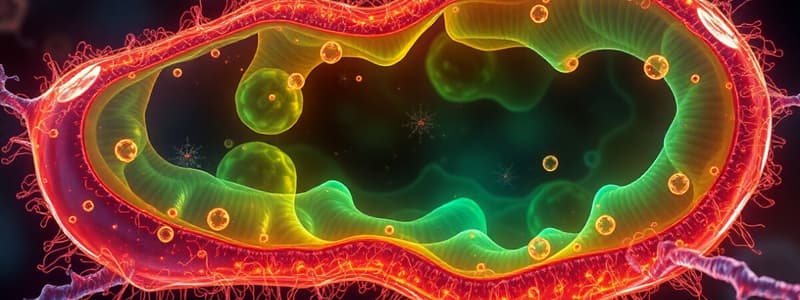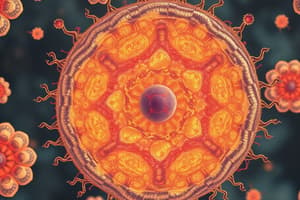Podcast
Questions and Answers
What is one of the primary types of substances that participates in energy flow within cells?
What is one of the primary types of substances that participates in energy flow within cells?
- Nucleic acids
- Proteins (correct)
- Hormones
- Enzymes
Which of the following is NOT a type of chemical component involved in cellular metabolism?
Which of the following is NOT a type of chemical component involved in cellular metabolism?
- Minerals (correct)
- Lipids
- Carbohydrates
- Vitamins
Energy flow in living cells primarily includes which of the following processes?
Energy flow in living cells primarily includes which of the following processes?
- Photosynthesis
- Cellular respiration (correct)
- Transcription
- Translation
Which chemical component is essential for metabolic reactions in cells?
Which chemical component is essential for metabolic reactions in cells?
Which of the following pairs includes components that are crucial for cellular function?
Which of the following pairs includes components that are crucial for cellular function?
What are ribosomes primarily responsible for in a cell?
What are ribosomes primarily responsible for in a cell?
Which statement best describes the role of a cell?
Which statement best describes the role of a cell?
Which of the following is NOT a function attributed to ribosomes?
Which of the following is NOT a function attributed to ribosomes?
What is the relationship between ribosomes and living organisms?
What is the relationship between ribosomes and living organisms?
What can be concluded about the structural nature of cells?
What can be concluded about the structural nature of cells?
What is one fundamental principle of modern cell theory?
What is one fundamental principle of modern cell theory?
Which statement best reflects the modern cell theory?
Which statement best reflects the modern cell theory?
According to modern cell theory, what role do cells play in living things?
According to modern cell theory, what role do cells play in living things?
Which of the following is NOT a characteristic of cells according to cell theory?
Which of the following is NOT a characteristic of cells according to cell theory?
What is implied by the statement 'all known living things are made up of one or more cells'?
What is implied by the statement 'all known living things are made up of one or more cells'?
What characteristic do all cells share?
What characteristic do all cells share?
Which of the following is true about cellular structures?
Which of the following is true about cellular structures?
What is the plasma membrane's primary function in cells?
What is the plasma membrane's primary function in cells?
Which statement about cells is incorrect?
Which statement about cells is incorrect?
Which of the following statements about plasma membranes is true?
Which of the following statements about plasma membranes is true?
What type of endoplasmic reticulum is characterized by the presence of ribosomes on its surface?
What type of endoplasmic reticulum is characterized by the presence of ribosomes on its surface?
Are lysosomes found exclusively in plant cells?
Are lysosomes found exclusively in plant cells?
What is the purpose of using methylene blue in staining processes?
What is the purpose of using methylene blue in staining processes?
Which type of endoplasmic reticulum is involved in the synthesis of lipids and detoxification of drugs?
Which type of endoplasmic reticulum is involved in the synthesis of lipids and detoxification of drugs?
Which of the following cellular components is incorrectly matched with its function?
Which of the following cellular components is incorrectly matched with its function?
Which statement about plasmids is true?
Which statement about plasmids is true?
In which of the following organisms are plasmids typically not found?
In which of the following organisms are plasmids typically not found?
Which option accurately identifies an organism that contains plasmids?
Which option accurately identifies an organism that contains plasmids?
What is a primary role of plasmids in bacteria?
What is a primary role of plasmids in bacteria?
Which of the following statements about plasmids is FALSE?
Which of the following statements about plasmids is FALSE?
Flashcards
Cellular energy flow
Cellular energy flow
The movement of energy within cells through metabolic and biochemical processes
Biochemical processes
Biochemical processes
Chemical processes occurring within living organisms; specifically within cells.
Metabolic processes
Metabolic processes
All chemical reactions occurring within a living organism, especially those that are part of energy transfer & conversion.
Cell
Cell
Signup and view all the flashcards
Essential Nutrients
Essential Nutrients
Signup and view all the flashcards
Ribosomes
Ribosomes
Signup and view all the flashcards
What is the function of ribosomes?
What is the function of ribosomes?
Signup and view all the flashcards
What makes a cell the basic unit of life?
What makes a cell the basic unit of life?
Signup and view all the flashcards
What are the three main functions of a cell?
What are the three main functions of a cell?
Signup and view all the flashcards
What are all living things made of?
What are all living things made of?
Signup and view all the flashcards
Cell Theory
Cell Theory
Signup and view all the flashcards
Unicellular
Unicellular
Signup and view all the flashcards
Multicellular
Multicellular
Signup and view all the flashcards
Cell Structure
Cell Structure
Signup and view all the flashcards
Plasma Membrane
Plasma Membrane
Signup and view all the flashcards
Common Features of Cells
Common Features of Cells
Signup and view all the flashcards
What does the plasma membrane do?
What does the plasma membrane do?
Signup and view all the flashcards
Why is the plasma membrane important?
Why is the plasma membrane important?
Signup and view all the flashcards
What are the main functions of a cell?
What are the main functions of a cell?
Signup and view all the flashcards
Rough ER
Rough ER
Signup and view all the flashcards
Smooth ER
Smooth ER
Signup and view all the flashcards
Where are lysosomes found?
Where are lysosomes found?
Signup and view all the flashcards
Methylene Blue Staining
Methylene Blue Staining
Signup and view all the flashcards
Plasmid
Plasmid
Signup and view all the flashcards
Where is a plasmid found?
Where is a plasmid found?
Signup and view all the flashcards
What does a plasmid do?
What does a plasmid do?
Signup and view all the flashcards
Antibiotic Resistance
Antibiotic Resistance
Signup and view all the flashcards
Bacterial Chromosome
Bacterial Chromosome
Signup and view all the flashcards
Study Notes
Cell Structure and Function
- Cells are the fundamental units of all living organisms.
- Cells perform all life functions.
- Cells can replicate independently.
- Modern cell theory states:
- All living things are made of one or more cells
- All cells arise from pre-existing cells.
- Cells are the basic unit of structure and function in all living organisms.
- The function of an organism depends on the activity of all its cells.
- Metabolism and energy flow occur in cells.
Prokaryotic vs. Eukaryotic Cells
- Two main types of cells: Prokaryotic and Eukaryotic.
- Prokaryotic cells:
- Lack a nucleus and other membrane-bound organelles.
- Typically smaller in size (0.1-5 micrometers).
- Include bacteria and archaea.
- Usually unicellular.
- Eukaryotic cells:
- Have a nucleus and membrane-bound organelles.
- Larger in size (10-100 micrometers).
- Include protists, fungi, plants, and animals.
- Can be unicellular or multicellular.
Common Cellular Features
- All cells share fundamental features:
- Plasma membrane (outer boundary)
- Cytoplasm (semifluid substance inside the cell)
- Chromosomes containing DNA (genetic material).
- Ribosomes (protein synthesis).
Prokaryotic Cells Experiment
- Prokaryotes (bacteria and archaea) lack a membrane-bound nucleus and internal organelles.
- Staining is used to visualize prokaryotic cells.
- Structures like flagella, pili, capsules, and cell walls are key features.
- Plasmids carry additional genetic material.
Eukaryotic Cells Experiment
- Eukaryotic cells contain membrane-bound organelles, including the nucleus.
- Structures like vacuoles, mitochondria, Golgi bodies, and endoplasmic reticulum play critical roles.
- Different types of eukaryotic cells (e.g., paramecium) have distinct features.
Studying That Suits You
Use AI to generate personalized quizzes and flashcards to suit your learning preferences.




